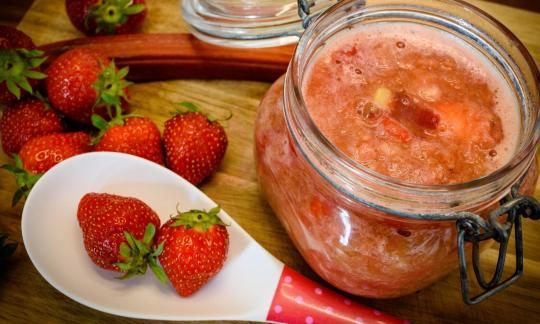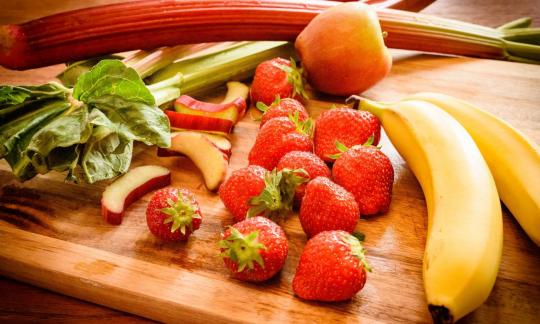Sugar-free rhubarb-strawberry compote with banana
vegan
Ingredients (for servings, )
| 8 ½ oz | Rhubarb, raw (organic?) |
| 8 ½ oz | Strawberries (organic?) |
| ½ | Oranges, raw (organic?) (2.3 oz) |
| 1 | Bananas, raw (organic?) (4.1 oz) |
Equipment
- stove
- citrus juicer (lemon squeezer)
- saucepan
Type of preparation
- cook
- chop or grind
- squeeze
Preparation
Preparation of compote
Wash the rhubarb, clean it (it is not necessary to peel it) and cut it into thin slices. Wash the strawberries too, cut off the leaves and halve or quarter them depending on their size. Put everything together in a pot. Squeeze the orange and add about 2-3 tablespoons of juice to the pot.You need just enough orange juice to prevent the compote from sticking.
Bring everything to the boil and simmer gently over a low heat for about 8 minutes until the fruit is soft. Stir occasionally to make sure it doesn't stick. Add a little more orange juice if necessary.
Meanwhile, proceed to step 3.
Peel the banana and use a fork to mash it into a fine puree.
I use one large or 2 small bananas - about 150-170 g for 4 portions.
Finishing the compote
Add the mashed banana to the remaining compote and mix once.You can enjoy the compote warm or cold, pure or with (vegan) ice cream or crêpes.
If stored in the refrigerator, you can keep the rhubarb-strawberry compote for 3 days.
|
Nutritional Information per person
Convert per 100g
|
2000 kcal | |
|---|---|---|
| Energy | 67 kcal | 3.4% |
| Fat/Lipids | 0.43 g | 0.6% |
| Saturated Fats | 0.08 g | 0.4% |
| Carbohydrates (inc.dietary fiber) | 16 g | 6.0% |
| Sugars | 8.9 g | 9.9% |
| Fiber | 3.5 g | 14.1% |
| Protein/Albumin | 1.5 g | 2.9% |
| Cooking Salt (Na:3.4 mg) | 8.7 mg | 0.4% |
| Essential micronutrients with the highest proportions | per person | 2000 kcal | |
|---|---|---|---|
| Vit | Vitamin C (ascorbic acid) | 53 mg | 66.0% |
| Vit | Vitamin K | 20 µg | 26.0% |
| Min | Manganese, Mn | 0.45 mg | 22.0% |
| Elem | Potassium, K | 411 mg | 21.0% |
| Vit | Folate, as the active form of folic acid (née vitamin B9 and | 30 µg | 15.0% |
| Vit | Vitamin B6 (pyridoxine) | 0.16 mg | 12.0% |
| Vit | Biotin (ex vitamin B7, H) | 4.9 µg | 10.0% |
| Elem | Calcium, Ca | 72 mg | 9.0% |
| Elem | Magnesium, Mg | 25 mg | 7.0% |
| Min | Copper, Cu | 0.07 mg | 7.0% |
Detailed Nutritional Information per Person for this Recipe
The majority of the nutritional information comes from the USDA (US Department of Agriculture). This means that the information for natural products is often incomplete or only given within broader categories, whereas in most cases products made from these have more complete information displayed.
If we take flaxseed, for example, the important essential amino acid ALA (omega-3) is only included in an overarching category whereas for flaxseed oil ALA is listed specifically. In time, we will be able to change this, but it will require a lot of work. An “i” appears behind ingredients that have been adjusted and an explanation appears when you hover over this symbol.
For Erb Muesli, the original calculations resulted in 48 % of the daily requirement of ALA — but with the correction, we see that the muesli actually covers >100 % of the necessary recommendation for the omega-3 fatty acid ALA. Our goal is to eventually be able to compare the nutritional value of our recipes with those that are used in conventional western lifestyles.
| Essential fatty acids | per person | 2000 kcal |
|---|---|---|
| Alpha-Linolenic acid; ALA; 18:3 omega-3 | 0.05 g | 3.0% |
| Linoleic acid; LA; 18:2 omega-6 | 0.14 g | 1.0% |
| Essential amino acids | per person | 2000 kcal |
|---|---|---|
| Tryptophan (Trp, W) | 0.01 g | 4.0% |
| Threonine (Thr, T) | 0.02 g | 2.0% |
| Isoleucine (Ile, I) | 0.02 g | 2.0% |
| Leucine (Leu, L) | 0.04 g | 2.0% |
| Lysine (Lys, K) | 0.04 g | 2.0% |
| Phenylalanine (Phe, F) | 0.03 g | 2.0% |
| Valine (Val, V) | 0.03 g | 2.0% |
| Methionine (Met, M) | 0.01 g | 1.0% |
| Vitamins | per person | 2000 kcal |
|---|---|---|
| Vitamin C (ascorbic acid) | 53 mg | 66.0% |
| Vitamin K | 20 µg | 26.0% |
| Folate, as the active form of folic acid (née vitamin B9 and | 30 µg | 15.0% |
| Vitamin B6 (pyridoxine) | 0.16 mg | 12.0% |
| Biotin (ex vitamin B7, H) | 4.9 µg | 10.0% |
| Thiamine (vitamin B1) | 0.05 mg | 5.0% |
| Pantothenic acid (vitamin B5) | 0.27 mg | 5.0% |
| Riboflavin (vitamin B2) | 0.06 mg | 4.0% |
| Niacin (née vitamin B3) | 0.67 mg | 4.0% |
| Vitamin E, as a-TEs | 0.41 mg | 3.0% |
| Vitamin A, as RAE | 6.4 µg | 1.0% |
| Essential macroelements (macronutrients) | per person | 2000 kcal |
|---|---|---|
| Potassium, K | 411 mg | 21.0% |
| Calcium, Ca | 72 mg | 9.0% |
| Magnesium, Mg | 25 mg | 7.0% |
| Phosphorus, P | 33 mg | 5.0% |
| Sodium, Na | 3.4 mg | < 0.1% |
| Essential trace elements (micronutrients) | per person | 2000 kcal |
|---|---|---|
| Manganese, Mn | 0.45 mg | 22.0% |
| Copper, Cu | 0.07 mg | 7.0% |
| Iron, Fe | 0.49 mg | 3.0% |
| Iod, I (Jod, J) | 3.9 µg | 3.0% |
| Zinc, Zn | 0.21 mg | 2.0% |
| Selenium, Se | 1.3 µg | 2.0% |
| Fluorine, F | 3.4 µg | < 0.1% |
This sugar-free rhubarb-strawberry compote with banana is a wonderfully fresh, fruity and healthy dessert.
Serving size: The indicated amount of 4 servings is sufficient for 4 desserts.
Nutrient profile: According to GDA guidelines, one portion of this recipe covers almost 70% of the average daily requirement of vitamin C and has just 67 kcal per portion. The sugar content comes solely from the fruit sweetness.
Rhubarb: Rhubarb is popular because of its refreshing, piquant-sour taste and low calorie content. Even though many valuable ingredients are usually lost when vegetables are cooked, rhubarb should be eaten cooked in large quantities. If eaten raw in large quantities, it deprives the body of important minerals such as calcium, magnesium and iron due to its high oxalic acid content. This can be dangerous, especially for children or people with gallbladder or kidney diseases.
Strawberries: Strawberries have a high vitamin C content, even more than lemons. In addition to vitamins, aromatic organic strawberries, especially wild strawberries, contain many minerals and health-promoting secondary plant substances.
Bananas: Bananas provide a very well-balanced mix of carbohydrates. As far as trace elements are concerned, bananas are the richest in copper of all known fruits. They also contain more iron than most fruits and are rich in potassium, phosphorus, magnesium and have a very high manganese content for a fruit.
Harvesting rhubarb yourself: Be careful when harvesting rhubarb yourself. You should not confuse wild rhubarb with the visually similar "wild rhubarb", butterbur! This contains pyrrolizidine alkaloids, which have a mutagenic, carcinogenic and possibly toxic effect on the liver. Even organic rhubarb leaves should not be eaten. Everything green on the plant is considered poisonous due to its oxalic acid content. The oxalic acid in the stems is considered harmless if harvested before mid to late June, because only after that does the oxalic acid content in the plant rise above a worrying level. The rhubarb rootstock is also quite poisonous. It contains anthraquinones. These are so poisonous that the root powder has been used in Asia for thousands of years to treat intestinal parasites such as amoebic dysentery and constipation.
Buying strawberries: Unlike apples and kiwis, strawberries are non-climacteric fruits and therefore do not ripen if picked too early. Therefore, you should pay attention to the color and scent when buying.
Juice: You can also use apple juice instead of orange juice.
Adjust the sweetness: The sweetness of the compote depends largely on the ripeness of the strawberries. It is advisable to use very aromatic, strong red strawberries. If you like it even sweeter, you can use more or riper bananas or increase the proportion of strawberries.






